Figure 1. Lebinthus luae male adult. Photograph by M. K. Tan.
Lebinthus luaeRobillard & Tan, 2013
Lua's cricket
Orthoptera: Gryllidae: Eneopterinae
Table of Contents
1. Overview
Lebinthus luae Robillard & Tan, 2013 or Lua’s cricket is one of the 23 species known from the genus Lebinthus Stal, 1877 (Fig. 1) [1]. This species was described from Singapore and is so far known only in Singapore and Indonesia [7]. It is also among the 195 species of Orthoptera known from Singapore. This cricket is named and dedicated to the insect curator of Lee Kong Chian Natural History Museum, Miss Lua Hui Kheng. The Lua’s cricket is brown and has distinctively truncated tegmen. It can be found in secondary dipterocarp forest and coastal forest in different parts of Singapore [7, 8, 9, 10, 11].2. Taxonomy and Systematics
2.1. Classification
Class: InsectaOrder: Orthoptera
Suborder: Ensifera
Family: Gryllidae Laicharting, 1781
Subfamily: Eneopterinae Saussure, 1893
Tribe: Lebinthini Robillard, 2004
Genus: //Lebinthus// Stal, 1877
The classification reflects relationship. Refers to the section Phylogeny for more information.
2.2. Type Information
Type locality: Asia-Tropical, Malesia, Malay Peninsula, Singapore, Labrador Nature ReserveKind of type: holotype
Specimen category: male
Depository of type: Zoological Reference Collection, Lee Kong Chian Natural History Museum
Synonym: None
2.3. Diagnosis and Identifying Features
Lebinthus luae was described from Singapore by Robillard & Tan (2013) [7]. The Lua’s cricket is very similar to another closely related species, Lebinthus bitaeniatus Stal, 1877. In fact, the Lebinthus species from Singapore was incorrectly identified as L. bitaeniatus until the recent re-examination of the types of L. bitaeniatus [3, 4, 5, 7]. Under the original description, Robillard & Tan (2013) [7] compared the new species from Singapore with L. bitaeniatus (Figs. 2 – 4).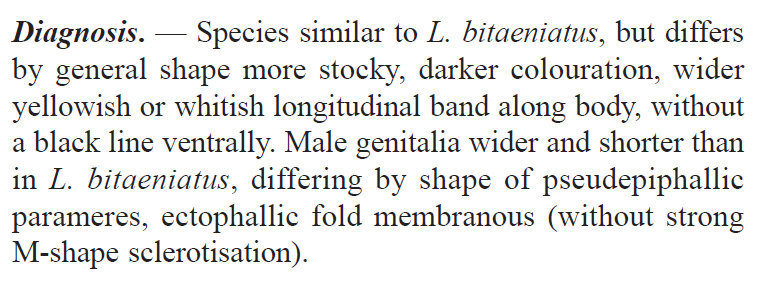
.
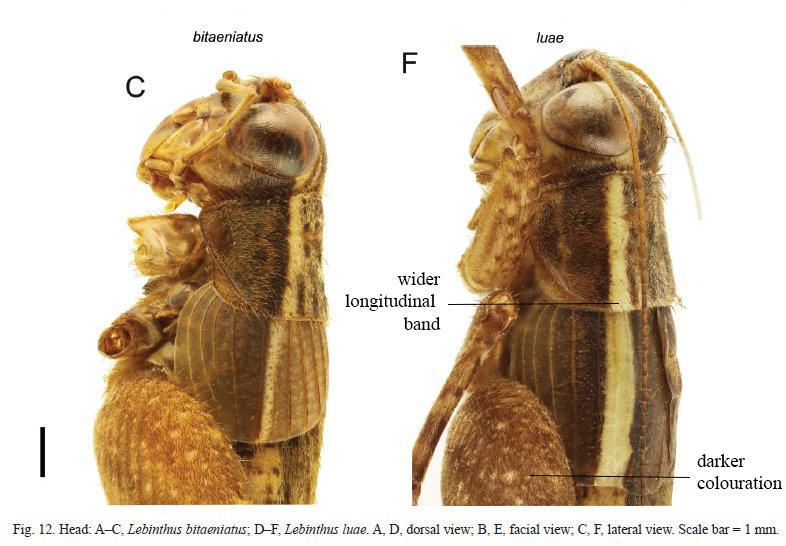
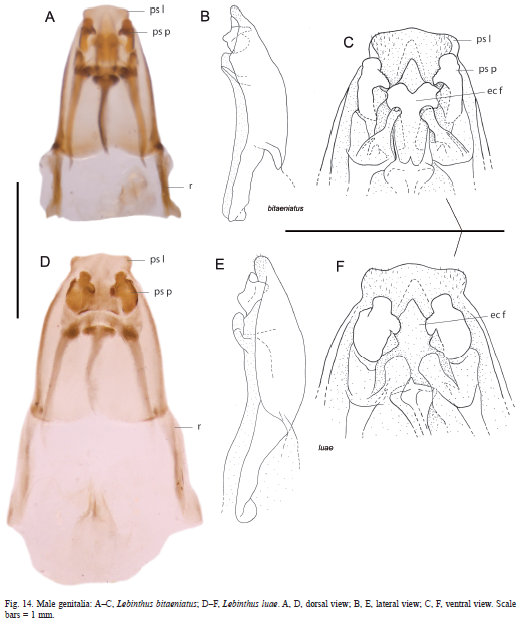
To a layman, this cricket can be differentiated from other crickets by brown body with wide yellow or whitish dorso-lateral longitudinal bands along the whole body; tegmen truncated, not reaching mid-length of abdomen (Fig. 5). Tan (2012) [9] provided illustrations of species from Bukit Timah and Central Catchment Nature Reserve and may be helpful for visual comparison with other crickets from Singapore. The nymphs are similar to adults but with darker brown colouration (Fig. 6).
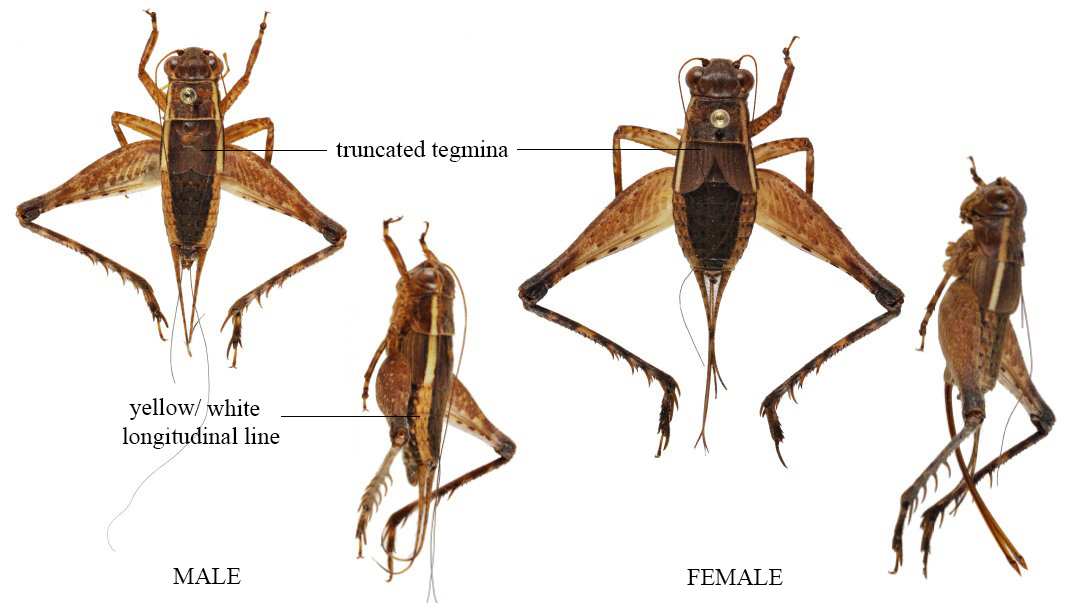
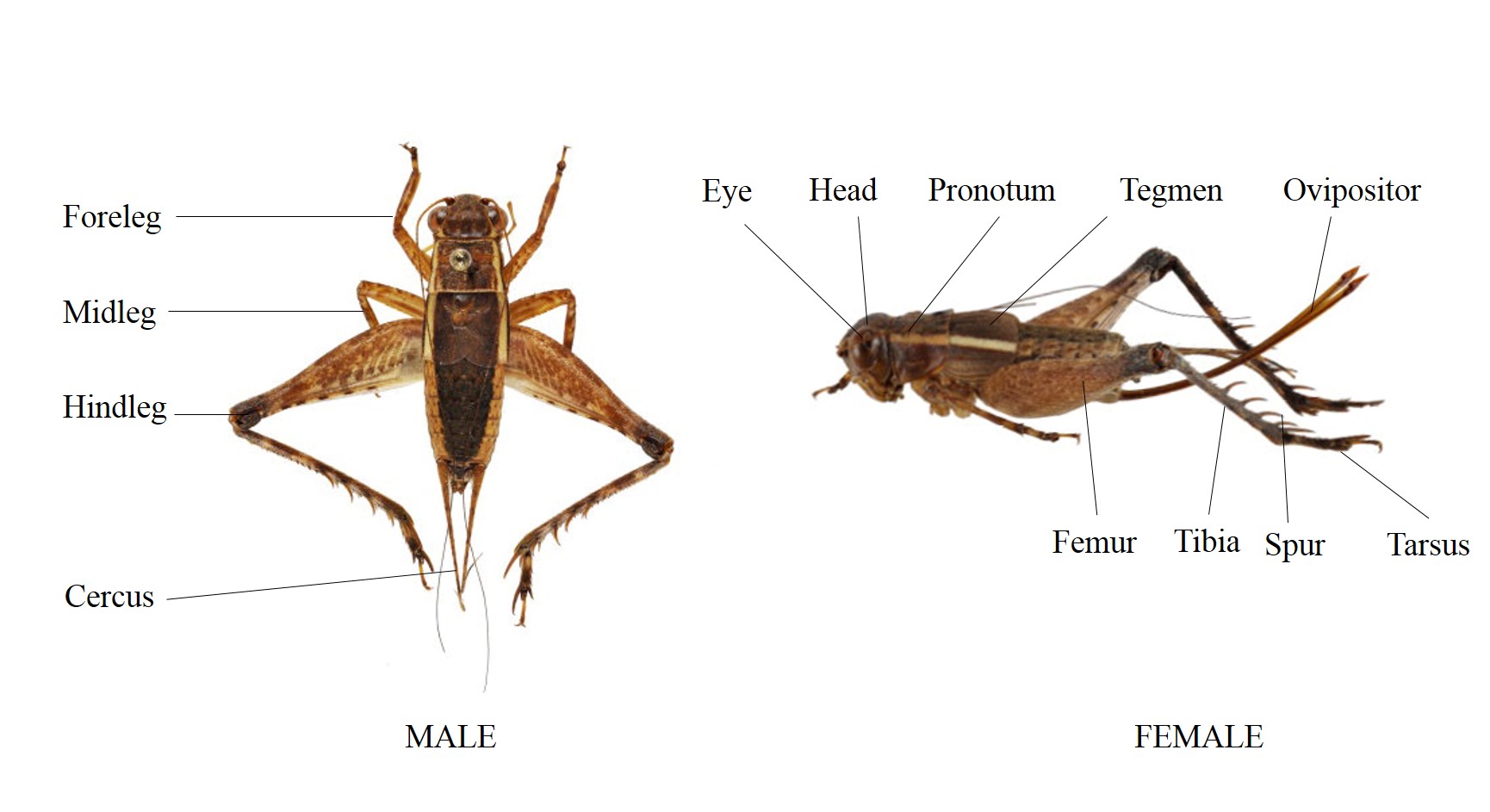
2.4. Identification Key
A key to species of Eneopterinae from Singapore was published recently [12] (Fig. 7):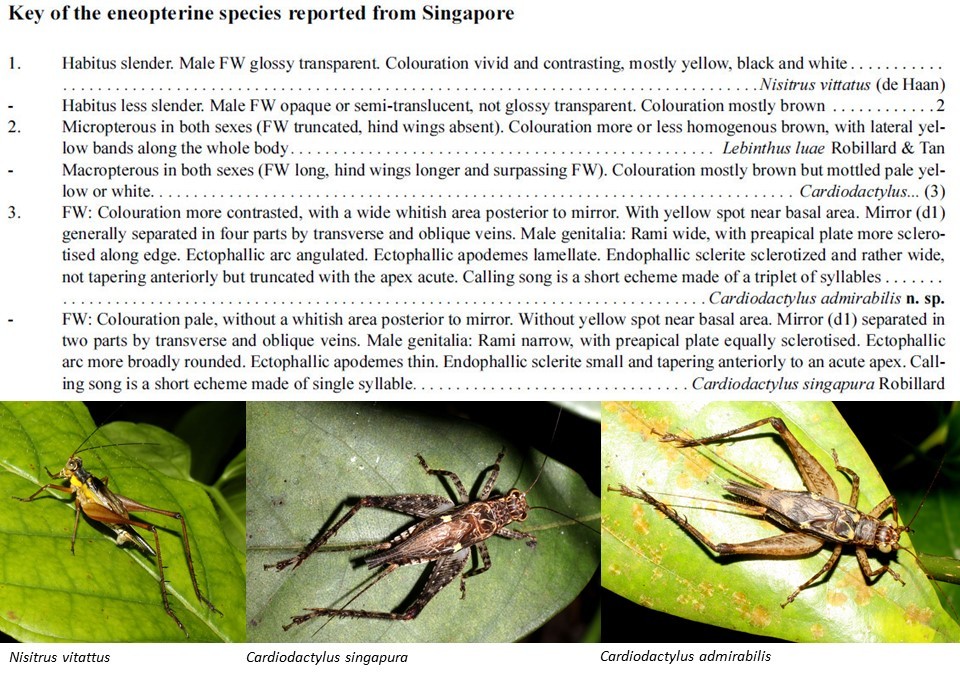
2.5. Phylogeny
Morphological and molecular characters had been used to reconstruct the phylogeny of Eneopterinae crickets [3, 6, 8]. The most recent consensus tree by Nattier et al. (2011) [3] agreed with previous findings [5, 6] that subfamily Eneopterinae and tribe Lebinthini are monophyletic groups (Fig. 8). Interestingly, the genus Lebinthus is not monophyletic as Agnotecous is nested within the Lebinthus. Given that only six species of Lebinthus was reflected on the tree compared to 23 known species, the current phylogeny remains incomplete. It is therefore hard to assess the relationship between L. luae and other species of Lebinthus. Note that in the most recent trees [3, 6, 8], the taxon L. bitaeniatus is in fact L. luae. This is because prior to the original description and review, the species from Singapore is wrongly identified as L. bitaeniatus [7].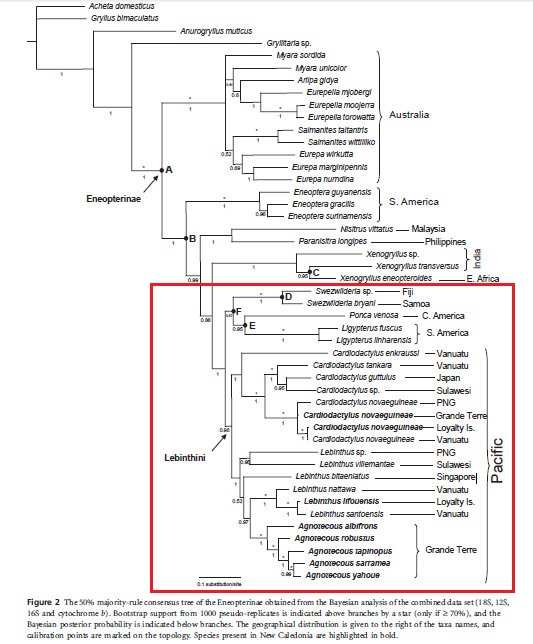
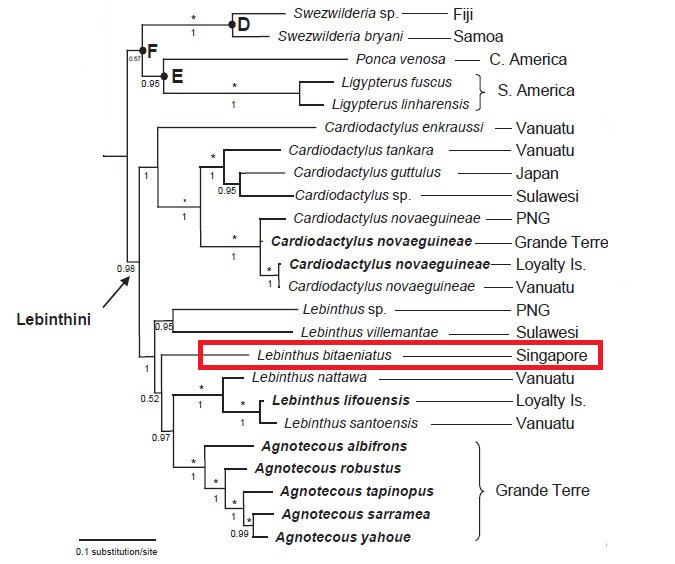
2.6. DNA barcodes
Partial sequences of 16S and cytochrome b genes are available for a male paratype (MNHN-ENSIF2740) and are available for download (in FASTA):ENSIF 2740 cytochrome b.fasta
ENSIF 2740 16S.fasta
Remarks: Note that the taxon is keyed as L. bitaeniatus instead of L. luae.
3. Natural History and Biology
3.1. Global distribution
The Lua’s cricket is so far known only from Singapore and parts of Indonesia (Fig. 9).Figure 9. Map of part of Southeast Asia indicating the currently known occurrence Lebinthus luae (Google, 2014) [2].
3.2. Local distribution
Figure 10. Map of Singapore indicating the currently known occurrence Lebinthus luae within Singapore (Google, 2014) [2]. Key: [1] Hindhede Nature Park, [2] Bukit Timah Nature Reserve, [3] Labrador Nature Reserve, [4] Sentosa, [5] Pulau Ubin, [6] Pulau Tekong and [7] Pulau Semakau Landfill.
3.3. Habitat
The Lua’s cricket can be found dwelling among the undergrowth of coastal forests in Sentosa, Labrador Nature Reserve, Pulau Semakau Landfill and Chek Jawa [7, 10, 11, 13]. Coastal forests are characterised by trees and plants that can withstand strong wind and high salinity in the soil and air [14]. It can also be found in the secondary/ primary dipterocarp forest in Bukit Timah Nature Reserve and Hindhede Nature Park [9].3.4. Life History
3.4.1. Diet
Little is known about the diet of the ground dwelling crickets but it is observed to feed on fallen fruits (Fig. 11) [7]. No other feeding observations were published but it may be suggested that they also feed on dead plant matter among the leaf litters. As such, the Lua's crickets may play some role as macrodecomposers and/or herbivores.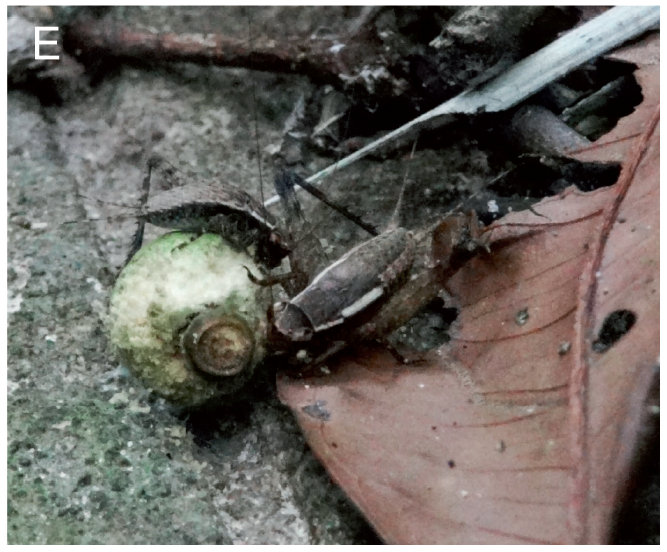
3.4.2. Mating behaviours
The Lua’s crickets are diurnal (active in the day) species and males can be observed calling for females from early morning to dusk. Male produces sounds by vibrating the forewings which causes the stridulatory file on each forewing to rub against one another. Male calling song consists of continuous pulses of short chirp (each lasting about 3.3 s) of peak frequency of 16.7 kHz (Fig. 12). Courtship behaviours also involve antennal communication between male and female. Mating couples are commonly sighted on leaves (Fig. 13). A video or sound file of the male calling song will be uploaded once available.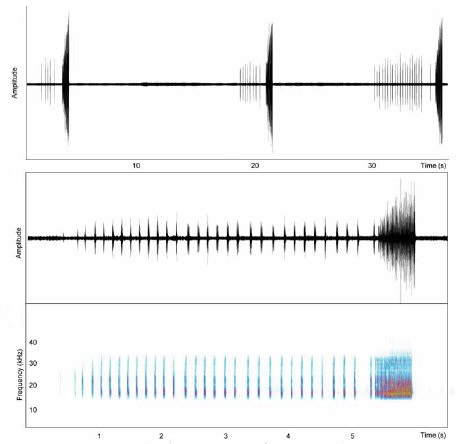
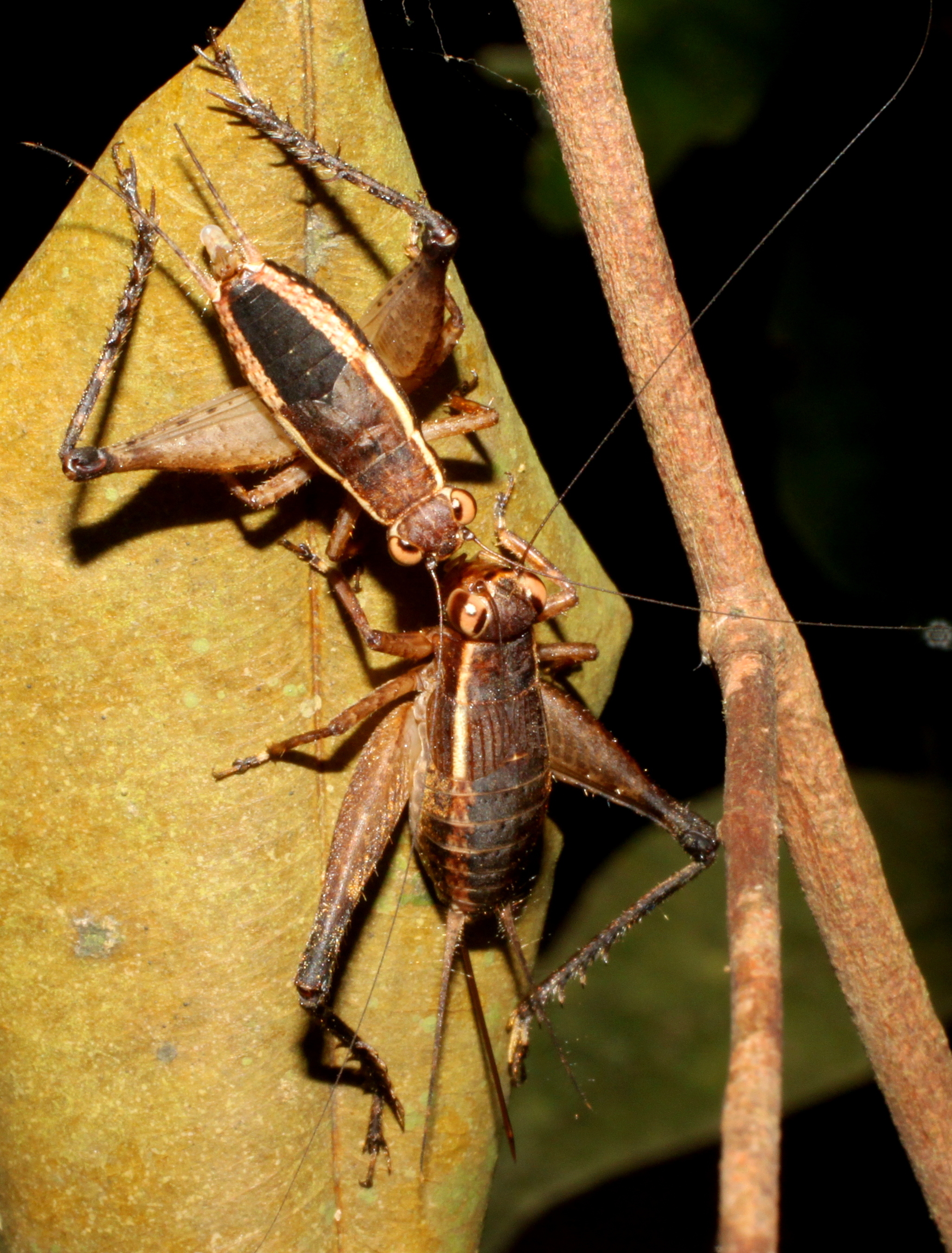
3.5. Conservation status (in Singapore)
Under current knowledge, the Lua’s cricket is known only from Singapore and Indonesia. It is so far known in only a few sites within Singapore but can be found in high abundances in these places. These include two of the four nature reserves: Bukit Timah Nature Reserve and Labrador Nature Reserve. Although there is no data on the population size in Singapore, a strict IUCN classification on the conservation status cannot be determined., according to the author’s observations, there is no immediate threat to the existence of the Lua’s cricket in Singapore.4. References
Links to full access of the references are provided whenever available:- Eades, D. C., D. Otte, M. M. Cigliano & H. Braun, 2013. Orthoptera Species File Online. Version 5.0/5.0. http://Orthoptera.SpeciesFile.org. (Accessed 11 Nov.2014).
- Google, 2014. Google Earth 7.1.2.2041. Google, California. http://earth.google.com/. (Accessed 11 Nov.2014).
- Nattier, R., T. Robillard, L. Desutter-Grandcolas, A. Couloux & P. Grandcolas, 2011. Older than New Caledonia emergence? A molecular phylogenetic study of the eneopterine crickets (Orthoptera: Grylloidea). Journal of Biogeography, 38: 2195–2209. [pdf]
- Robillard, T. & L. Desutter-Grandcolas, 2004. Phylogeny and the modalities of acoustic diversification in extant Eneopterinae (Insecta, Orthoptera, Grylloidea, Eneopteridae). Cladistics, 20: 271–293. [pdf]
- Robillard, T. & L. Desutter-Grandcolas, 2006. Phylogeny of the cricket subfamily Eneopterinae (Insecta, Orthoptera, Grylloidea, Eneopteridae) based on four molecular loci and morphology. Molecular Phylogenetics and Evolution, 40: 643–661. [pdf]
- Robillard, T. & L. Desutter-Grandcolas, 2008. Clarification of the taxonomy of extant crickets of the subfamily Eneopterinae (Orthoptera: Grylloidea; Gryllidae). Zootaxa, 1789: 66–68. [pdf]
- Robillard, T. & M. K. Tan, 2013. A taxonomic review of common but little known crickets from Singapore and the Philippines (Insecta: Orthoptera: Eneopterinae). The Raffles Bulletin of Zoology, 61(2): 705–725. [pdf]
- Tan, M. K., 2010. Orthoptera in Pulau Ubin. Nature in Singapore, 3: 245–268. [pdf]
- Tan, M. K., 2012. Orthoptera in the Bukit Timah and Central Catchment Nature Reserves (Part 2): Suborder Ensifera. Raffles Museum of Biodiversity Research, National University Singapore, Singapore. 70 pp. Uploaded 14 Nov.2012. [pdf]
- Tan, M. K., 2013. Orthoptera in the mangroves of Singapore. Nature in Singapore, 6: 289–230. [pdf]
- Tan, M. K., R. W. J. Ngiam & M. R. B. Ismail, 2012. A checklist of Orthoptera in Singapore parks. Nature in Singapore, 5: 61–67. [pdf]
- Tan, M. K. & T. Robillard, 2014. A new species of Cardiodactylus (Orthoptera: Grylloidea: Eneopterinae) from Singapore. Zootaxa, 3764(3): 364–376. [pdf]
- Tan, M. K. & L. K. Wang, 2012. The Orthoptera of Semakau Landfill, Singapore: A Project Semakau checklist. Nature in Singapore, 5: 309–318. [pdf]
- Tan, R., 2014. Wild Singapore Factsheet: Coastal Plants. Wild Singapore. http://www.wildsingapore.com/wildfacts/plants/coastal/coastalplants.htm. Accessed 22 Nov.2014).